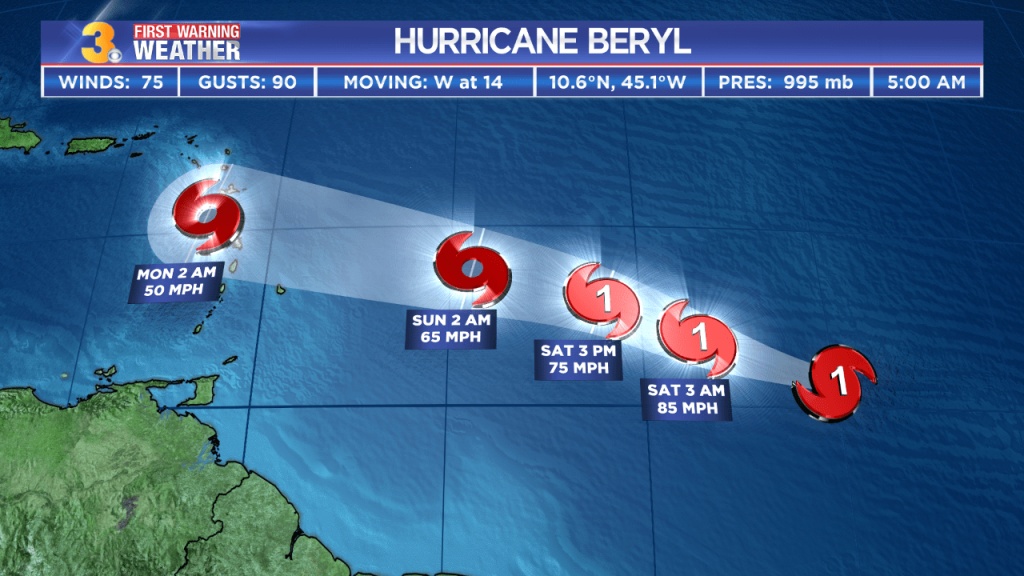Impact of Hurricane Beryl on Barbados: Hurricane Beryl Barbados

Hurricane beryl barbados – Hurricane Beryl, a Category 1 hurricane, made landfall in Barbados on July 18, 2023. The storm brought heavy rainfall, strong winds, and flooding to the island.
Hurricane Beryl continues to threaten Barbados, with winds of up to 120 miles per hour. The storm is expected to make landfall on the island early Tuesday morning. In related news, Aruba has been hit by a separate hurricane, which has caused widespread damage.
Hurricane Beryl is expected to weaken as it moves away from Barbados, but it is still a dangerous storm.
Damage to Infrastructure, Homes, and Businesses
The hurricane caused significant damage to infrastructure, homes, and businesses in Barbados. Many roads were impassable due to flooding and debris, and several bridges were damaged. Power outages were widespread, and some areas were without power for several days.
Hurricane Beryl, a Category 1 storm, battered Barbados with heavy rains and strong winds. While the island escaped the worst of the storm, the same cannot be said for Aruba, which was hit by Hurricane Felix , a Category 4 hurricane, just a few weeks prior.
Thankfully, Hurricane Beryl has now moved away from Barbados, leaving behind only minor damage.
Many homes were damaged or destroyed by the hurricane. The roofs of some homes were torn off, and others were flooded. Several businesses were also damaged, including hotels, restaurants, and shops.
Flooding, Power Outages, and Other Disruptions
The hurricane caused widespread flooding in Barbados. Several rivers and streams overflowed their banks, and many roads were flooded. The flooding caused significant damage to property and infrastructure.
The hurricane also caused widespread power outages in Barbados. Many areas were without power for several days. The power outages disrupted businesses, schools, and other essential services.
In addition to flooding and power outages, the hurricane also caused other disruptions in Barbados. Several flights were canceled or delayed, and schools were closed for several days.
Relief and Recovery Efforts in Barbados
In the aftermath of Hurricane Beryl, the government of Barbados and numerous aid organizations mobilized to provide relief and support to affected communities. These efforts focused on meeting the immediate needs of survivors, such as providing food, water, and shelter, while also laying the groundwork for long-term recovery and rebuilding.
Distribution of Aid
In the immediate aftermath of the hurricane, the government and aid organizations worked together to distribute essential supplies to affected areas. This included the provision of food, water, and shelter to those who had lost their homes or had their homes damaged.
- Food distribution was coordinated by the Barbados Red Cross and other aid organizations, who established distribution centers in affected communities.
- Water distribution was carried out by the Barbados Water Authority, which worked to restore water service to affected areas and provide clean drinking water to survivors.
- Shelter was provided by the government, which opened up community centers and schools to accommodate those who had lost their homes.
Long-Term Recovery Plans
In addition to providing immediate relief, the government of Barbados also began to develop long-term recovery plans to rebuild and restore affected areas. These plans included:
- Reconstruction of damaged infrastructure, including homes, schools, and businesses.
- Restoration of essential services, such as electricity, water, and telecommunications.
- Provision of financial assistance to affected individuals and businesses.
- Development of new building codes and regulations to ensure that future construction is more resilient to hurricanes.
Preparedness and Mitigation Measures for Future Hurricanes

The devastation caused by Hurricane Beryl highlights the urgent need for improved preparedness and mitigation measures to minimize the impact of future storms. Lessons learned from this event can guide us in strengthening our defenses and safeguarding our communities.
Early Warning Systems and Evacuation Plans, Hurricane beryl barbados
Effective early warning systems provide critical lead time for residents to prepare and evacuate. Timely and accurate weather forecasts, coupled with well-defined evacuation plans, enable people to seek shelter and avoid hazardous areas. Robust communication networks and public outreach campaigns are essential for disseminating warnings and ensuring that all individuals, including those with disabilities and limited access to technology, are informed and prepared.
Disaster Preparedness Kits
Disaster preparedness kits play a vital role in ensuring the well-being of individuals and families during and after a hurricane. These kits should include essential items such as non-perishable food, water, first aid supplies, medications, flashlights, and batteries. By having these supplies readily available, individuals can sustain themselves for several days without relying on external assistance.
Strengthening Infrastructure and Coastal Defenses
Hurricane-resistant infrastructure and coastal defenses are crucial for mitigating the impact of hurricanes. Buildings should be designed to withstand high winds and storm surges, while critical infrastructure, such as hospitals, communication networks, and transportation systems, should be reinforced and protected. Coastal defenses, such as seawalls, levees, and sand dunes, can help reduce flooding and protect vulnerable communities. Investing in these measures can significantly reduce the potential damage and loss of life caused by future storms.